Hydrogen Sulfide Adsorption from Natural Gas Using Silver-Modified 13X Molecular Sieve
Abstract
:1. Introduction
2. Materials and Methods
2.1. Reagents and Materials
2.2. Synthesis of Ag Ion-Exchanged 13X
2.3. Characterization
2.4. H2S Gas Separation
2.5. Adsorption Capacity
- MW = molecular weight of H2S (g/mol);
- Cin = inlet H2S concentration (ppmv);
- t1 = breakthrough time when the outlet concentration is 1 ppmv (h);
- t0 = breakthrough time at the last detection of 0 ppmv (h);
- Vm = molar volume (24,414 Nl/mol);
- M = mass of adsorbent material (g).
2.6. Methodology
3. Results and discussion
3.1. XRD Analysis
3.2. SEM Images
3.3. BET Analysis
3.4. H2S Adsorption
3.5. Effect of Inlet Gas Composition
3.6. Effect of Ag Concentration
3.7. Adsorption Mechanism
3.8. Adsorption Isotherms
4. Conclusions
Author Contributions
Funding
Institutional Review Board Statement
Informed Consent Statement
Data Availability Statement
Conflicts of Interest
References
- International Energy Agency. World Energy Outlook 2023; Licence: Creative Commons Attribution CC BY-NC-SA 4.0; IEA: Paris, France, 2023. [Google Scholar]
- Duval, S. Natural gas sweetening. In Surface Process, Transportation, and Storage; Gulf Professional Publishing: Houston, TX, USA, 2023; pp. 37–78. [Google Scholar]
- Mokhatab, S.; Poe, W.A.; Mak, J.Y. Handbook of Natural Gas Transmission and Processing: Principles and Practices; Gulf Professional Publishing: Houston, TX, USA, 2018. [Google Scholar] [CrossRef]
- Chan, Y.H.; Lock, S.S.M.; Wong, M.K.; Yiin, C.L.; Loy, A.C.M.; Cheah, K.W.; Chai, S.Y.W.; Li, C.; How, B.S.; Chin, B.L.F.; et al. A state-of-the-art review on capture and separation of hazardous hydrogen sulfide (H2S): Recent advances, challenges and outlook. Environ. Pollut. 2022, 314, 120219. [Google Scholar] [CrossRef] [PubMed]
- Hedayat, M.; Soltanieh, M.; Mousavi, S.A. Simultaneous separation of H2S and CO2 from natural gas by hollow fiber membrane contactor using mixture of alkanolamines. J. Memb. Sci. 2011, 377, 191–197. [Google Scholar] [CrossRef]
- Shah, M.S.; Tsapatsis, M.; Siepmann, J.I. Hydrogen Sulfide Capture: From Absorption in Polar Liquids to Oxide, Zeolite, and Metal-Organic Framework Adsorbents and Membranes. Chem. Rev. 2017, 117, 9755–9803. [Google Scholar] [CrossRef]
- de Oliveira, L.H.; Meneguin, J.G.; Pereira, M.V.; do Nascimento, J.F.; Arroyo, P.A. Adsorption of hydrogen sulfide, carbon dioxide, methane, and their mixtures on activated carbon. Chem. Eng. Commun. 2019, 206, 1544–1564. [Google Scholar] [CrossRef]
- Castrillon, M.C.; Moura, K.O.; Alves, C.A.; Bastos-Neto, M.; Azevedo, D.C.S.; Hofmann, J.; Möllmer, J.; Einicke, W.D.; Gläser, R. CO2 and H2S Removal from CH4-Rich Streams by Adsorption on Activated Carbons Modified with K2CO3, NaOH, or Fe2O3. Energy Fuels 2016, 30, 9596–9604. [Google Scholar] [CrossRef]
- Zulkefli, N.N.; Masdar, M.S.; Roslam Wan Isahak, W.N.; Jahim, J.M.; Md Rejab, S.A.; Lye, C.C. Removal of hydrogen sulfide from a biogas mimic by using impregnated activated carbon adsorbent. PLoS ONE 2019, 14, e0211713. [Google Scholar] [CrossRef]
- Belmabkhout, Y.; Bhatt, P.M.; Adil, K.; Pillai, R.S.; Cadiau, A.; Shkurenko, A.; Maurin, G.; Liu, G.G.; Koros, W.J.; Eddaoudi, M. Natural gas upgrading using a fluorinated MOF with tuned H2S and CO2 adsorption selectivity. Ind. Eng. Chem. Res. 2020, 25, 111886. [Google Scholar] [CrossRef]
- Liu, G.; Cadiau, A.; Liu, Y.; Adil, K.; Chernikova, V.; Carja, I.D.; Belmabkhout, Y.; Karunakaran, M.; Shekhah, O.; Zhang, C.; et al. Enabling Fluorinated MOF-Based Membranes for Simultaneous Removal of H2S and CO2 from Natural Gas. Angew. Chem. Int. Ed. 2018, 57, 14811–14816. [Google Scholar] [CrossRef]
- Mohammadi, A.; Saadati, Z.; Joohari, S. Comparison of the adsorption of H2S by ZnO–TiO2 and Ni–ZnO–TiO2 nanoparticles: An adsorption isotherm and thermodynamic study. Environ. Prog. Sustain. Energy 2019, 38, e13258. [Google Scholar] [CrossRef]
- Jiang, D.; Su, L.; Ma, L.; Yao, N.; Xu, X.; Tang, H.; Li, X. Cu-Zn-Al mixed metal oxides derived from hydroxycarbonate precursors for H2S removal at low temperature. Appl. Surf. Sci. 2010, 256, 3216–3223. [Google Scholar] [CrossRef]
- Yu, T.; Chen, Z.; Liu, Z.; Xu, J.; Wang, Y. Review of Hydrogen Sulfide Removal from Various Industrial Gases by Zeolites. Separations 2022, 9, 229. [Google Scholar] [CrossRef]
- Abdirakhimov, M.; Al-Rashed, M.H.; Wójcik, J. Recent Attempts on the Removal of H2S from Various Gas Mixtures Using Zeolites and Waste-Based Adsorbents. Energies 2022, 15, 5391. [Google Scholar] [CrossRef]
- Huang, Y.; Su, W.; Wang, R.; Zhao, T. Removal of Typical Industrial Gaseous Pollutants: From Carbon, Zeolite, and Metal-organic Frameworks to Molecularly Imprinted Adsorbents. Aerosol Air Qual. Res. 2019, 19, 2130–2150. [Google Scholar] [CrossRef]
- Sigot, L.; Fontseré Obis, M.; Benbelkacem, H.; Germain, P.; Ducom, G. Comparing the performance of a 13X zeolite and an impregnated activated carbon for H2S removal from biogas to fuel an SOFC: Influence of water. Int. J. Hydrogen Energy 2016, 41, 18533–18541. [Google Scholar] [CrossRef]
- Bandarchian, F.; Anbia, M. Conventional hydrothermal synthesis of nanoporous molecular sieve 13X for selective adsorption of trace amount of hydrogen sulfide from mixture with propane. J. Nat. Gas Sci. Eng. 2015, 26, 1380–1387. [Google Scholar] [CrossRef]
- Yang, K.; Su, B.; Shi, L.; Wang, H.; Cui, Q. Adsorption Mechanism and Regeneration Performance of 13X for H2S and SO2. Energy Fuels 2018, 32, 12742–12749. [Google Scholar] [CrossRef]
- Starke, A.; Pasel, C.; Bläker, C.; Eckardt, T.; Zimmermann, J.; Bathen, D. Investigation of the Adsorption of Hydrogen Sulfide on Faujasite Zeolites Focusing on the Influence of Cations. ACS Omega 2022, 7, 43665–43677. [Google Scholar] [CrossRef]
- Pudi, A.; Rezaei, M.; Signorini, V.; Andersson, M.P.; Baschetti, M.G.; Mansouri, S.S. Hydrogen sulfide capture and removal technologies: A comprehensive review of recent developments and emerging trends. Sep. Purif. Technol. 2022, 298, 121448. [Google Scholar] [CrossRef]
- Barelli, L.; Bidini, G.; Micoli, L.; Sisani, E.; Turco, M. 13X Ex-Cu zeolite performance characterization towards H2S removal for biogas use in molten carbonate fuel cells. Energy 2018, 160, 44–53. [Google Scholar] [CrossRef]
- Long, N.Q.; Vuong, H.T.; Ha, H.K.P.; Kuniawan, W.; Hinode, H.; Baba, T. Preparation, characterization and H2S adsorptive removal of ion-exchanged zeolite X. J. Chem. Phys. 2016, 5, 4–12. [Google Scholar] [CrossRef]
- Chen, X.; Shen, B.; Sun, H.; Zhan, G. Ion-exchange modified zeolites X for selective adsorption desulfurization from Claus tail gas: Experimental and computational investigations. Microporous Mesoporous Mater. 2018, 261, 227–236. [Google Scholar] [CrossRef]
- Kumar, P.; Sung, C.Y.; Muraza, O.; Cococcioni, M.; Al Hashimi, S.; McCormick, A.; Tsapatsis, M. H2S adsorption by Ag and Cu ion exchanged faujasites. Microporous Mesoporous Mater. 2011, 146, 127–133. [Google Scholar] [CrossRef]
- Kulawong, S.; Artkla, R.; Sriprapakhan, P.; Maneechot, P. Biogas purification by adsorption of hydrogen sulphide on NaX and Ag-exchanged NaX zeolites. Biomass Bioenergy 2022, 159, 106417. [Google Scholar] [CrossRef]
- Zhu, L.; Lv, X.; Tong, S.; Zhang, T.; Song, Y.; Wang, Y.; Hao, Z.; Huang, C.; Xia, D. Modification of zeolite by metal and adsorption desulfurization of organic sulfide in natural gas. J. Nat. Gas Sci. Eng. 2019, 69, 102941. [Google Scholar] [CrossRef]
- Gates-Rector, S.; Blanton, T. The Powder Diffraction File: A quality materials characterization database. Powder Diffr. 2019, 34, 352–360. [Google Scholar] [CrossRef]
- Baerlocher, C.; McCusker, L.B. Database of Zeolite Structures. Available online: https://www.iza-structure.org/databases/ (accessed on 22 October 2023).
- Brunauer, S.; Emmett, P.H.; Teller, E. Adsorption of Gases in Multimolecular Layers. J. Am. Chem. Soc. 1938, 60, 309–319. [Google Scholar] [CrossRef]
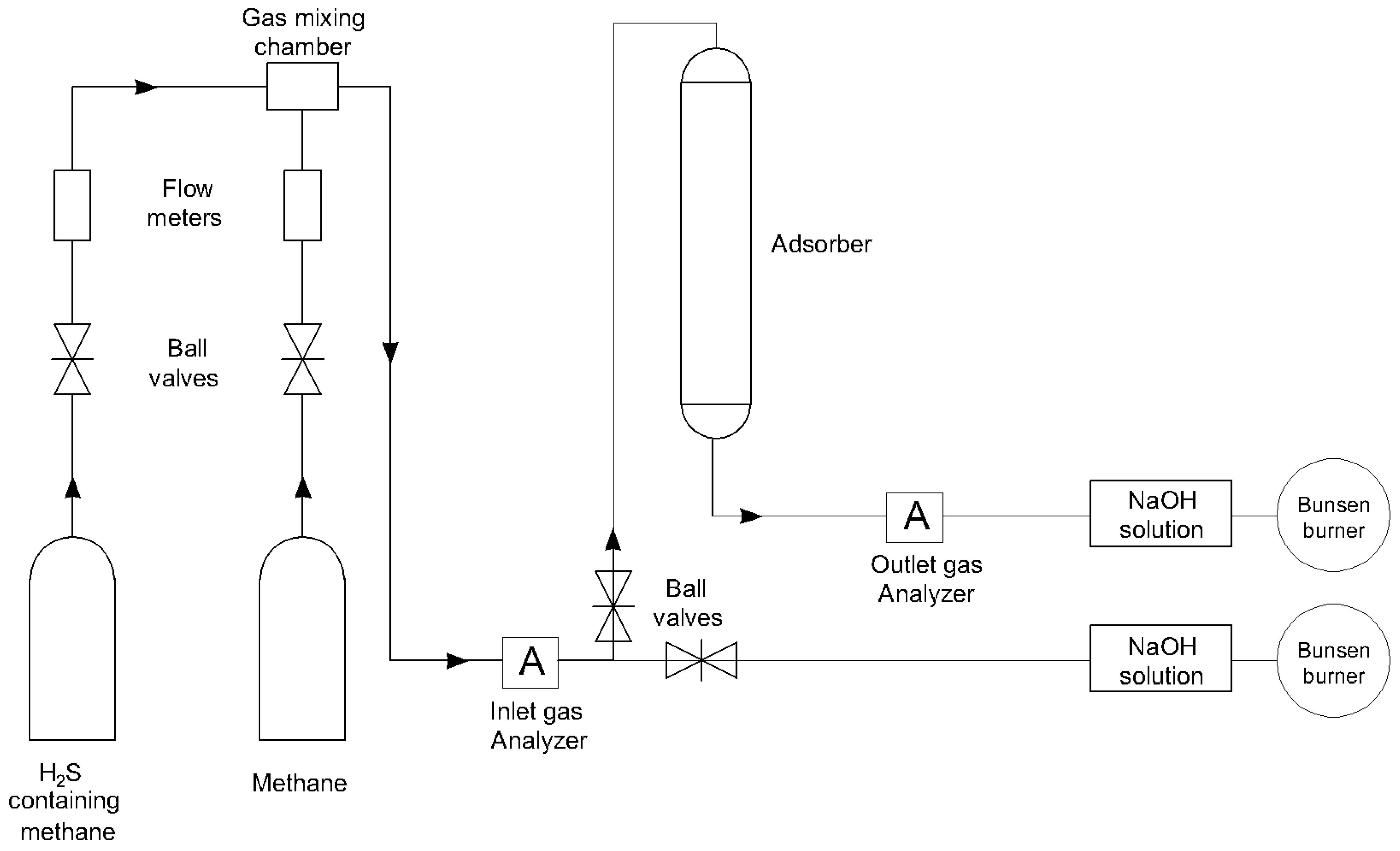
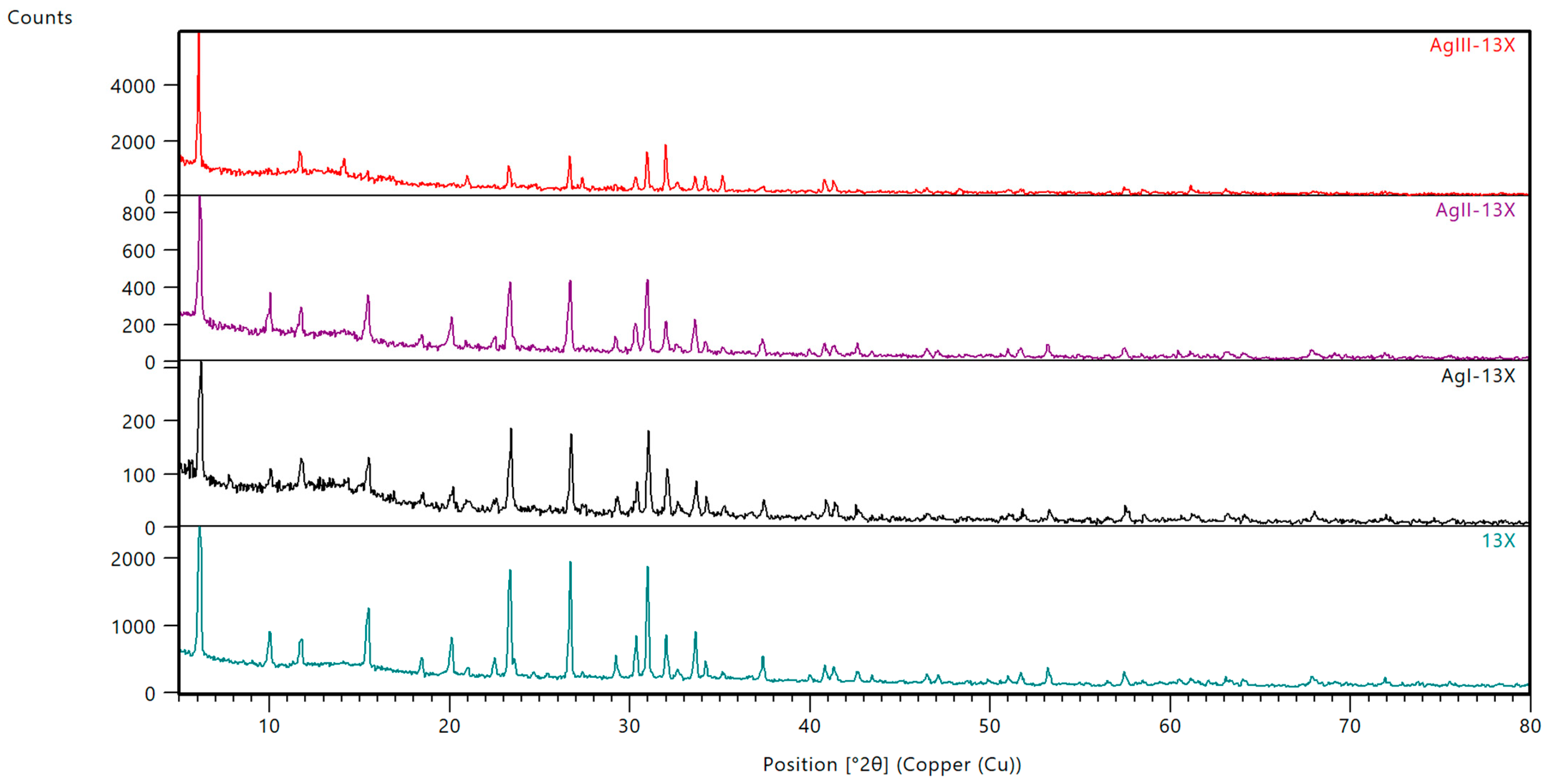
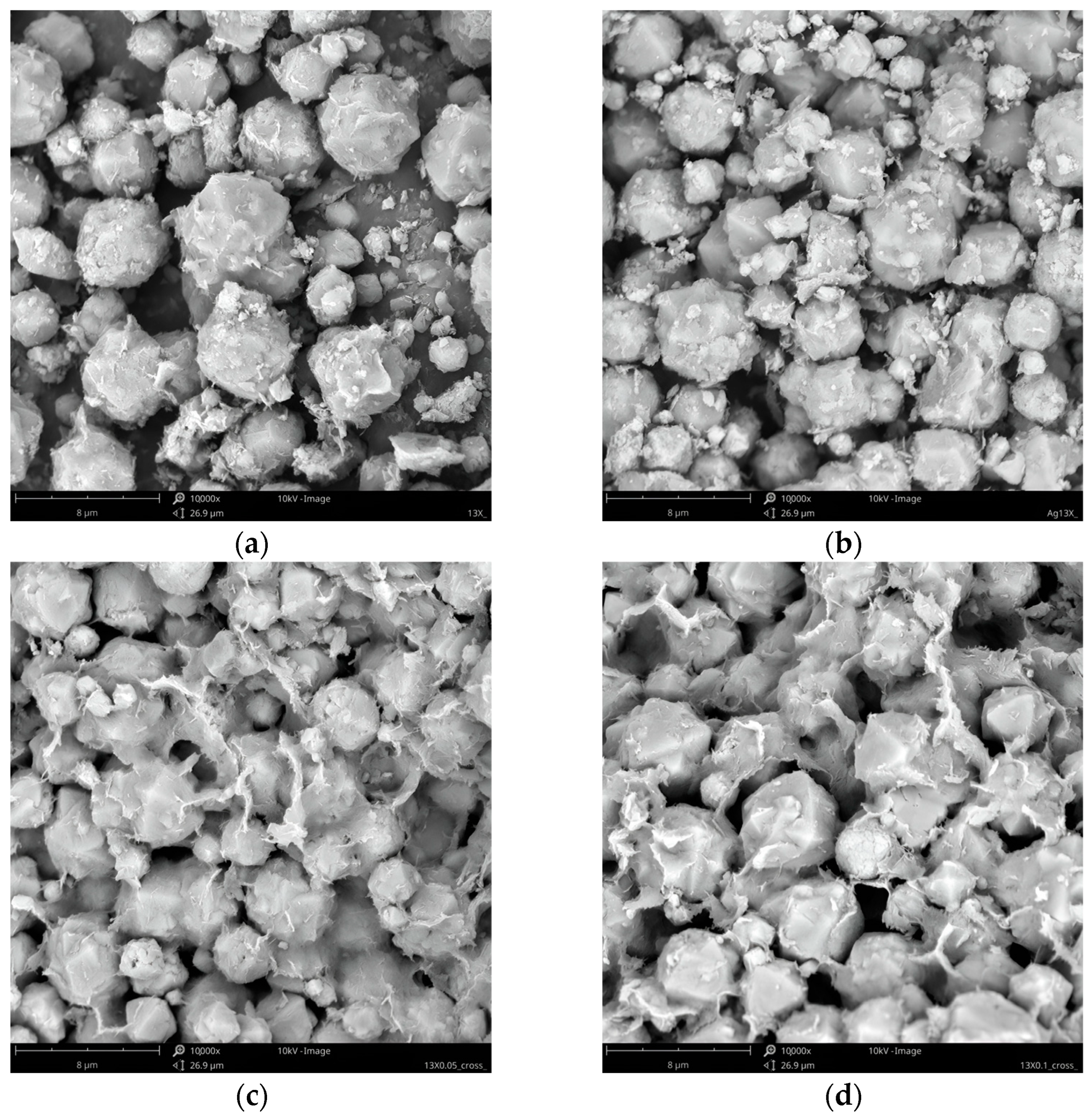

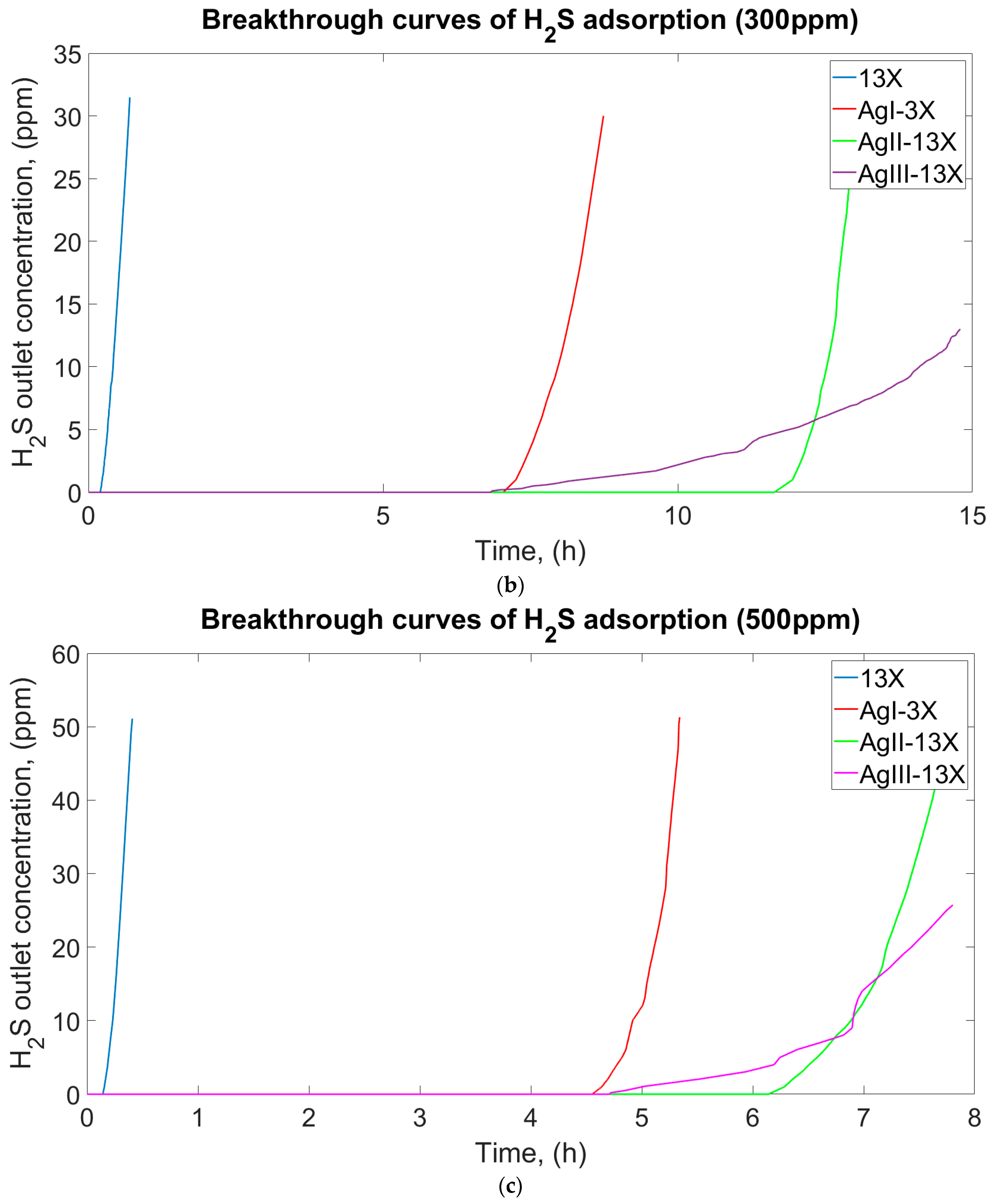
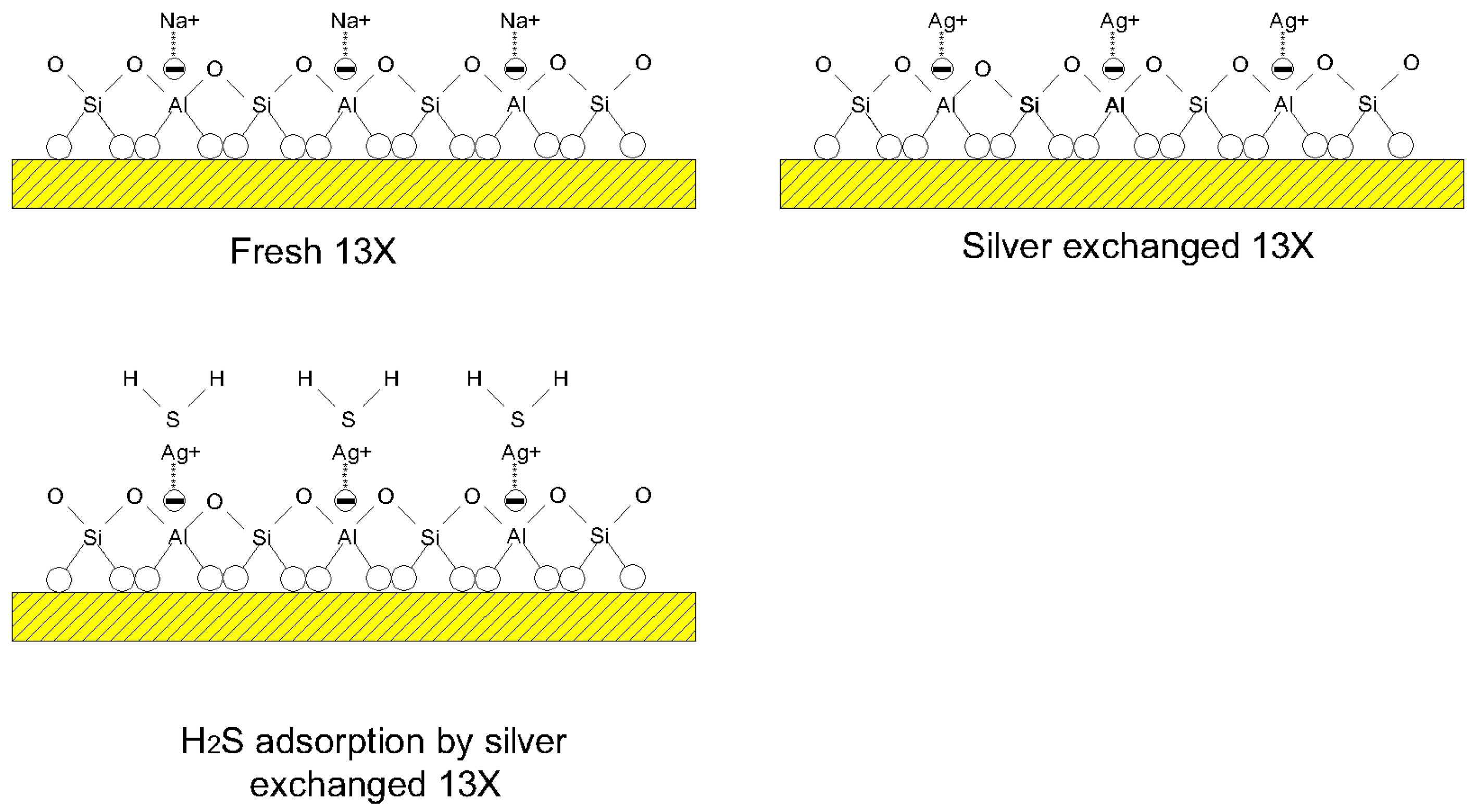
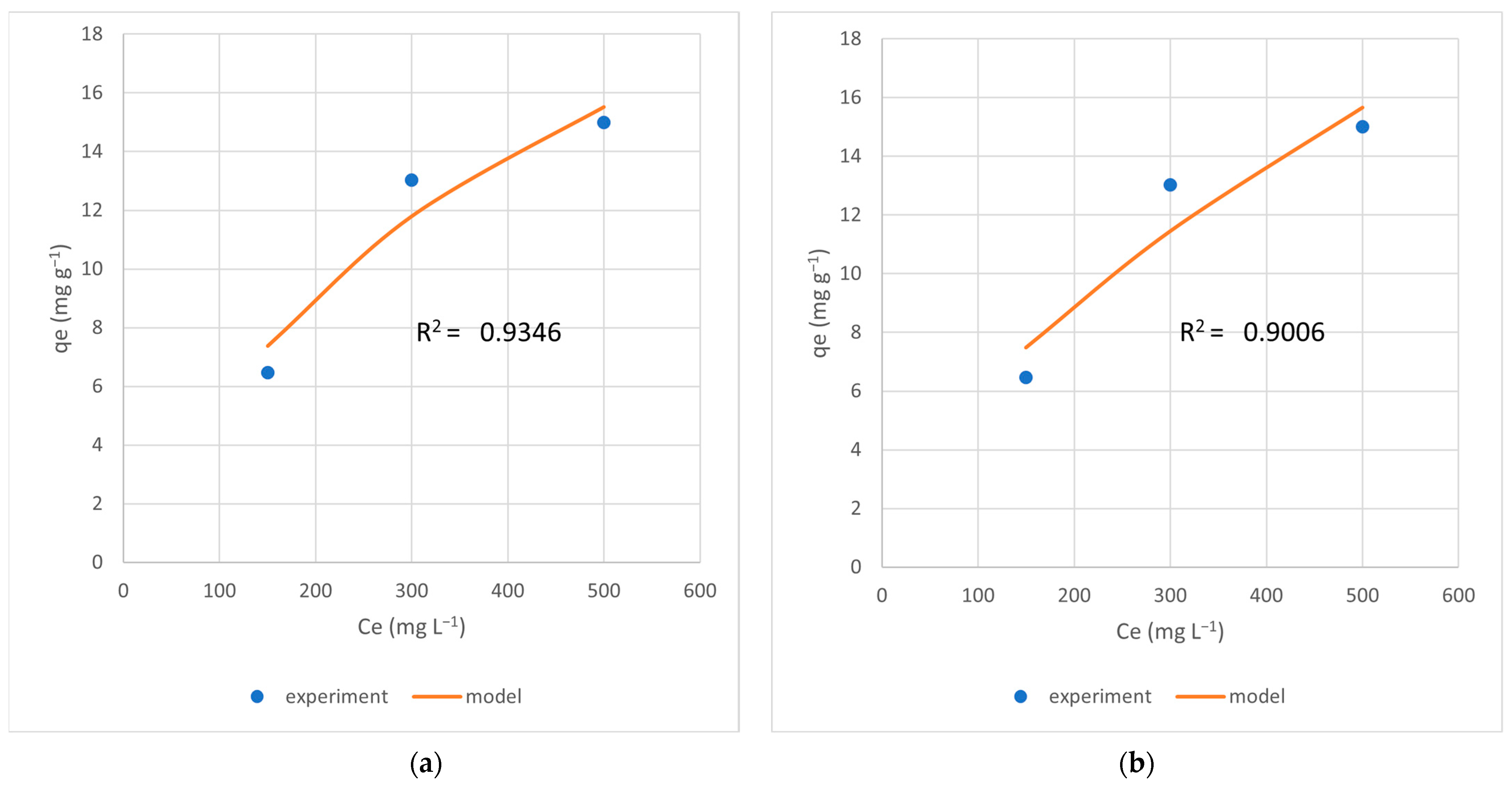
| Element | Elemental Composition in wt.% | |||
|---|---|---|---|---|
| 13X | AgI-13X | AgII-13X | AgIII-13X | |
| O | 55.81 | 51.83 | 46.80 | 39.24 |
| Si | 21.20 | 18.93 | 16.20 | 14.31 |
| Al | 15.74 | 12.27 | 9.40 | 11.13 |
| Na | 6.89 | 5.79 | 2.38 | 2.07 |
| Mg | 0.35 | 0.94 | 1.55 | 0.43 |
| Ag | - | 10.24 | 21.32 | 32.38 |
| Σ | 99.99 | 100 | 97.65 | 99.56 |
| Adsorbents | BET Surface Area (m2/g) |
|---|---|
| 13X | 501.33 |
| AgI-13X | 436 |
| AgII-13X | 416 |
| AgIII-13X | 405 |
| Adsorbents | Effective Adsorption Capacity (mg/g) | ||
|---|---|---|---|
| 150 ppm | 300 ppm | 500 ppm | |
| 13X | 0.238 | 0.254 | 0.26 |
| AgI-13X | 2.405 | 7.92 | 8.44 |
| AgII-13X | 6.47 | 13.05 | 11.44 |
| AgIII-13X | 4.92 | 9.1 | 9.15 |
| Adsorbents | Breakthrough Time (h) | ||
|---|---|---|---|
| 150 ppm | 300 ppm | 500 ppm | |
| 13X | 0.435833 | 0.232778 | 0.1425 |
| AgI-13X | 4.403889 | 7.253611 | 4.638611 |
| AgII-13X | 11.84806 | 11.9475 | 6.284444 |
| AgIII-13X | 11.87917 | 8.338889 | 5.03 |
| Langmuir | Value | Freundlich | Value |
|---|---|---|---|
| KL (µM−1) | 0.002229 | KF (mmol m−2 µM−1/n) | 0.347795 |
| R2 (Ce vs. qe) | 0.9346 | R2 (Ce vs. qe) | 0.9006 |
| qmax (mg g−1) | 29.42685 | n | 1.632228 |
Disclaimer/Publisher’s Note: The statements, opinions and data contained in all publications are solely those of the individual author(s) and contributor(s) and not of MDPI and/or the editor(s). MDPI and/or the editor(s) disclaim responsibility for any injury to people or property resulting from any ideas, methods, instructions or products referred to in the content. |
© 2023 by the authors. Licensee MDPI, Basel, Switzerland. This article is an open access article distributed under the terms and conditions of the Creative Commons Attribution (CC BY) license (https://creativecommons.org/licenses/by/4.0/).
Share and Cite
Abdirakhimov, M.; Al-Rashed, M.H.; Wójcik, J. Hydrogen Sulfide Adsorption from Natural Gas Using Silver-Modified 13X Molecular Sieve. Materials 2024, 17, 165. https://doi.org/10.3390/ma17010165
Abdirakhimov M, Al-Rashed MH, Wójcik J. Hydrogen Sulfide Adsorption from Natural Gas Using Silver-Modified 13X Molecular Sieve. Materials. 2024; 17(1):165. https://doi.org/10.3390/ma17010165
Chicago/Turabian StyleAbdirakhimov, Mirzokhid, Mohsen H. Al-Rashed, and Janusz Wójcik. 2024. "Hydrogen Sulfide Adsorption from Natural Gas Using Silver-Modified 13X Molecular Sieve" Materials 17, no. 1: 165. https://doi.org/10.3390/ma17010165
APA StyleAbdirakhimov, M., Al-Rashed, M. H., & Wójcik, J. (2024). Hydrogen Sulfide Adsorption from Natural Gas Using Silver-Modified 13X Molecular Sieve. Materials, 17(1), 165. https://doi.org/10.3390/ma17010165






